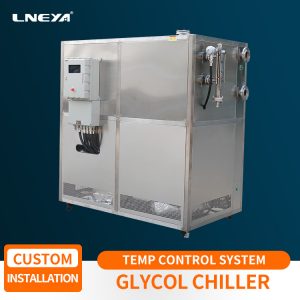Install a refrigeration unit for the circulating cooling water of the quenching tank
The quenching tank is a container filled with quenching medium. When the workpiece is immersed in the tank for cooling, it must be able to ensure that the workpiece is uniformly quenched at a reasonable cooling rate. It is a container that provides sufficient cooling capacity for the quenching of the workpiece to meet the technical requirements .
The quenching tank structure is relatively simple, mainly composed of tank body, medium input or discharge pipe, overflow tank, etc., and some are additionally equipped with heaters, coolers, stirrers and smoke exhaust fire prevention devices. The temperature of the quenching medium is one of the important factors affecting the quenching effect of the workpiece. Therefore, strictly controlling the temperature of the medium in the quenching tank is a measure to ensure the quality of heat treatment.
There are mainly three types of quenching tanks, oil tanks and bath tanks on the market. Here we mainly talk about the quenching tank. According to the cooling method, the water-cooling type has higher cooling efficiency, but because the temperature of the cooling water needs to be controlled, a sufficiently large cooling pool must be established. At the same time, the circulating cooling of the cooling water also requires the addition of a chiller unit to the quenching tank.
For large production batches, continuous production or large quenching tanks, the heated quenching medium is discharged into the cooling system for circulating cooling. Circulating replacement cooling water consumes a lot of resources, so additional refrigeration units are good news for manufacturers. The refrigeration temperature range of LNEYA cycle refrigeration unit is -150°C to -5°C, which can meet the needs of different refrigeration temperatures. The refrigeration speed is fast and can be frozen to -120°C within 3 minutes after stable operation. LNEYA provides equipment on-site installation and system testing. Users only need to complete the installation of refrigerant and cooling water.
Related recommendations
-
Precautions for small laboratory water chiller before and after startup
1878In the pharmaceutical and chemical industry, small laboratory water chillers are widely used refrigeration equipment, which are often used in various reaction kettles for refrigeration reactions. In order to maintain the stable operation of the e...
View details -
Precautions for the Placement of Industrial Air Cooled Chiller
2233The quality and use of industrial air cooled chillers are very important. At the same time, the user operation cannot ignore the position placement. Only the correct position placement and high-quality equipment can achieve high-efficiency operati...
View details -
LNEYA Low temperature thermostatic bath instructions
1970Low temperature thermostat is widely used in petroleum, chemical industry, electronic instruments, physical, chemical and biological engineering, medicine and health, life sciences, food industry, physical testing and chemical analysis and researc...
View details -
Refrigeration and heating temperature control system for aerospace vacuum heat sink testing
1317The application of refrigeration and heating temperature control system in aerospace vacuum environment heat sink testing is very critical. Such equipment is usually used to simulate thermal performance tests under extreme temperature cond...
View details
 LNEYA Industrial Chillers Manufacturer Supplier
LNEYA Industrial Chillers Manufacturer Supplier















